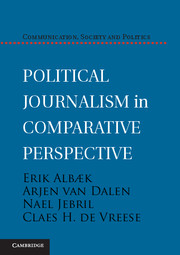Book contents
- Frontmatter
- Contents
- List of Tables and Figures
- Preface
- 1 Introduction
- 2 Comparing Political Journalism
- 3 Journalists
- 4 Journalists and Politicians
- 5 Do Role Conceptions Matter?
- 6 What Type of Journalism Produces Public Knowledge?
- 7 Does Infotainment Journalism Lead to Political Cynicism?
- 8 Good Journalism, Satisfied Citizens?
- 9 Political Journalism
- Appendix to Chapter 2
- Appendix to Chapter 3
- Appendix to Chapter 4
- Appendix to Chapter 5
- Appendix to Chapter 6
- Appendix to Chapter 7
- Appendix to Chapter 8
- References
- Index
2 - Comparing Political Journalism
Published online by Cambridge University Press: 05 June 2014
- Frontmatter
- Contents
- List of Tables and Figures
- Preface
- 1 Introduction
- 2 Comparing Political Journalism
- 3 Journalists
- 4 Journalists and Politicians
- 5 Do Role Conceptions Matter?
- 6 What Type of Journalism Produces Public Knowledge?
- 7 Does Infotainment Journalism Lead to Political Cynicism?
- 8 Good Journalism, Satisfied Citizens?
- 9 Political Journalism
- Appendix to Chapter 2
- Appendix to Chapter 3
- Appendix to Chapter 4
- Appendix to Chapter 5
- Appendix to Chapter 6
- Appendix to Chapter 7
- Appendix to Chapter 8
- References
- Index
Summary
In Chapter 1 we presented the book's focus and rationale. We study the influence of the conditions under which politicians, journalists, and audiences interact on the contribution which political journalism makes to democratic processes. To study this we (1) investigate journalists’ backgrounds and attitudes toward covering politics, (2) define, identify, and analyze different types of political news reporting, and (3) investigate the effects of different types of political reporting on political perception and cognition. We address this question using a cross-national, multi-methods comparative design combining the following methods:
–Surveys among political journalists in Denmark, Germany, the United Kingdom, and Spain
–A content analysis of political news in Denmark, Germany, the United Kingdom, and Spain
–A panel study, combined with a content analysis, of political news and news about the U.S. presidential elections in Denmark, the United Kingdom, and Spain.
Before briefly presenting the studies, we first lay out two key requirements for the study of the link between the structural conditions in which journalists work and the content and effects of the news they produce. Comparative research can clarify the way characteristics of the media system (Hallin & Mancini, 2004b) affect the way political journalists work and the news they produce. But in order to do so, the first requirement is a careful case selection. Like many comparative studies, our case selection takes its starting point in Hallin and Mancini's media system framework. We present the Hallin and Mancini model, discuss potential pitfalls when applying it in comparative research, and present the way our countries fit within this framework. A second requirement in order to link structural conditions to production, content, and effects is a multi-method design. We explain why this is required and lay out the connection between our three types of studies. But first we take a step back to introduce the comparative nature of our endeavor.
- Type
- Chapter
- Information
- Political Journalism in Comparative Perspective , pp. 15 - 33Publisher: Cambridge University PressPrint publication year: 2014

